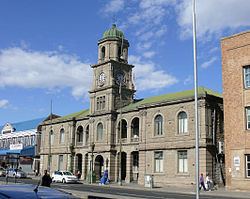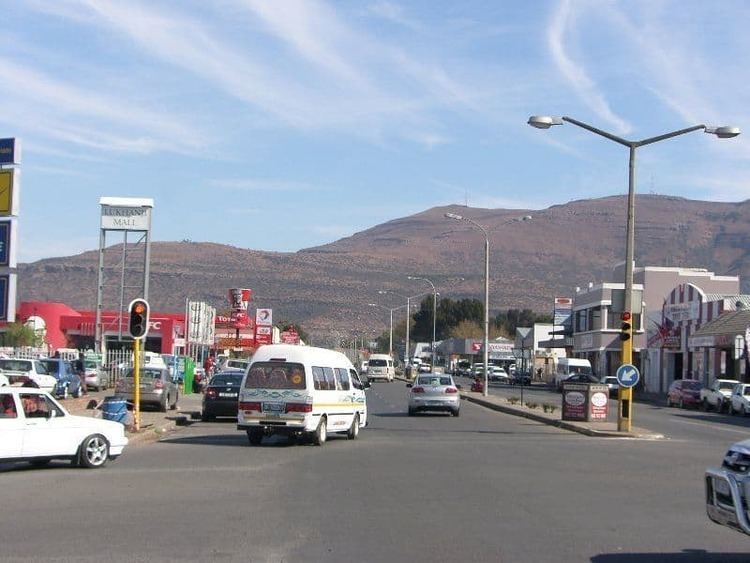Country South Africa Area 71.3 km2 Founded 1853 | Language spoken Xhosa District Chris Hani | |
 | ||
Map of Queenstown, Eastern Cape
Komani, formerly known as Queenstown, is a town in the middle of the Eastern Cape Province of South Africa, roughly halfway between the smaller towns of Cathcart and Sterkstroom. It is currently the commercial, administrative, and educational centre of the prosperous surrounding farming district.
Contents
- Map of Queenstown Eastern Cape
- Snow in queenstown eastern cape south africa mp4
- Lukhanji tourism organisation queenstown promotion
- History
- Education
- Environment
- The Hexagon
- City Layout
- Geology
- Media
- Sports
- Municipal 1
- Municipal 2
- References

Its former nickname of the town, 'Rose Capital of South Africa', comes from the large gardens and open places for flowers (especially roses) in and around town.

The city is the seat of the Roman Catholic Diocese of Queenstown. Churches of all faith denominations are to be found in and around Komani.
Snow in queenstown eastern cape south africa mp4
Lukhanji tourism organisation queenstown promotion
History
The town was founded in early 1853 under the direction of Sir George Cathcart, who named the settlement, and then fort, after Queen Victoria. Work on its railway connection to East London on the coast was begun by the Cape government of John Molteno in 1876, and the line was officially opened on 19 May 1880. The town prospered from its founding up to the worldwide depression of the 1930s, and again thereafter. In the 1960s, the majority of the Black population were moved east to the township of Ezibeleni, as part of the attempt to move African people to so-called "homelands". The area has in the past had very severe weather problems, luckily, often only affecting the surrounding areas. In 2002, heavy snowfall around Queenstown caused a severe disaster, especially since the area was not funded or ready for such a disaster. Then, in 2004, the surrounding areas of the Eastern Cape were affected by strong winds and heavy rainfall, although Queenstown once again escaped much flooding and some wind damage, power shortages soon followed. Other natural disasters include droughts and veld fires (wild fires).
Education
Queen's College, Get Ahead Project and College, Queenstown Girls' High School, Hangklip High School, Kwa Komani Comprehensive, Maria Louw High School, Nkwanca High School, Luvuyo Lerumo High School, John Noah High School, W.B. Rubusana High Shool & Bulelani High School are among well-known secondary schools in Queenstown. The former has produced many fine sportsmen, including Tony Greig, Daryll Cullinan, Kenny McEwan, Kaya Malotana, Lionel Cronje, Justin Kemp, Robbi Kempson, Dick Muir, Carlo Del Fava and Lwazi Mvovo.
Excellent Afrikaans schools, namely Hangklip Primary and Senior set high standards academically and on the sport field. Balmoral Girls' Primary School and Queens College Primary are two renowned primary schools in the town.
Tertiary education institutions in Queenstown include Walter Sisulu University, Ikhala Public FET College, Boston City Campus and Business College and Lukhanji FET College.
Environment
Komani (Queenstown) lies on the Komani River which forms part of the Great Kei system of rivers and has a refreshing climate and plentiful water supply from the surrounding rugged mountains. The water is collected in Bonkolo (named changed from Bongolo recently) Dam, set in the hills, used extensively for recreation and watersports. Each year, around the beginning of June, the town holds an art exhibition with the emphasis on paintings and sculpture. Perhaps inspired by some of the most interesting Bushman paintings in nearby caves, which are accessible to the visitor.
Close to Komani is a nature reserve (Lawrence de Lange Game Reserve) with numerous antelope, white rhinoceros and spectacular flowering plants together with panoramic views from the mountain summit.
The Hexagon
The layout of Komani (Queenstown) reflects its original objective as a defensive stronghold for the frontier area and has a most unusual design. There is a central hexagonal area where canon or rifle fire could be directed down six thoroughfares radiating from the centre. The canon sites have now been replaced with gardens and a central fountain was the dominant feature. A striking abstract sculpture replaced the fountain as part of the town's 150th anniversary. The hexagon still exists, with the outer road surrounding it named Robinson Road, which encircles it. Surrounding the Hexagon to the east and west lies more commercial and administrative facilities.
City Layout
Like all South African towns the city is heavily segregated, and although black citizens are now free to travel, work, live and shop in the commercial sectors and housing areas, there is some integration. The vast majority of the black population do not earn enough money to live in the more wealthy suburbs. Currently, formerly 'white suburbs' surround the hexagon to the north, east and west, however, one of the city's great townships (and squatter camps) lies to the south. It is a collection of black and coloured townships named Mlungisi, Aloevale and many others, but due to continued expansions, a new township, Victoria Park has been built to the south-east of the city. As for the actual city of Komani (Queenstown), it includes the suburbs of Sandringham, Kingsway, Windsor, Bergsig, Blue rise, Balmoral, Madeira Park and a new fast-growing suburb of Komani Park. In recent years, growth has been slow in this part of the city, with the only real expansion being in a few small gated communities in Komani Park and in the north of the town.
East of the town lies the much larger Ezibeleni township, which although roughly the same surface area as Komani (Queenstown), has by far a larger population.
Geology
The Komani (Queenstown) area is in the Burgersdorp formation of the Tarkastad sub group, in the upper Beaufort Group Triassic in age in the karoo super group. The lithology is red mudstone 1 to 10 m rich layers and sub-ordinate 1 to 2 m rich sandstone layers deposited by meandering rivers in the flood plain in an oxidising environment gradually filling the Karoo basin. The formation reaches thickness of 600 m in the Komani (Queenstown) and Lady Frere area (S.gcobo). Numerous dolerite dykes and ring structures intruded the area creating good localities for ground water exploration.
Media
Community media also forms an integral part of Komani (Queenstown). The town has a newspaper called The Representative, fondly known as the Rep, as well as The Express and a community radio station, Lukhanji fm. The Eastern Cape newspaper, Daily Dispatch, is widely read in the area.
Sports
Municipal (1)
The Queenstown municipal council assumed a pseudo-heraldic coat of arms in October 1902.
The shield was quartered, and depicted (1) the Union Jack, (2) a landscape with hangklip mountain in the background, (3) a landscape with a mimosa tree in the foreground, and (4) a portrait of King Edward VII. The crest was a demi-antelope, and the motto Unity is strength.
Municipal (2)
The council later assumed a new coat of arms. The new shield displayed a golden royal coronet on a red background. The crest was the same as before, but the motto was translated into Latin as Ex unitate vires.
